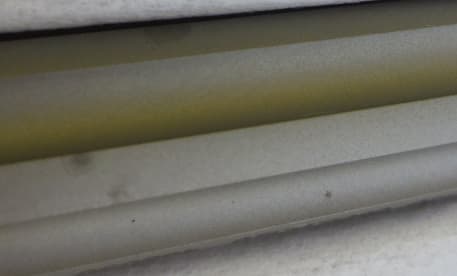
Curated with aloha by
Ted Mooney, P.E. RET

The authoritative public forum
for Metal Finishing 1989-2025

-----
Passivation Stains on 17-4 PH Stainless Steel
this text gets replaced with bannerText

Q. My team has just passivated some 17-4 PH Stainless steel parts using nitric 2 passivation process. Our parts have yielded some stains randomly across the parts, any idea what could be causing these stains? We empty the tanks and clean the unit often.






- Pittsburgh Pennsylvania
March 8, 2023
A. Hi Justin. My suspicion is either that --
• the parts (not the tank) were not truly clean -- are the cleaning tank,passivation tank, and all the rinse tanks free of floating oil on their surfaces?
• there was poor rinsing involved that either dried in place or allowed what Anna describes below (an attack by weak nitric acid which left staining.
• oil, grease or other contaminants are falling on the parts after processing.
These stains don't look to me even vaguely like a material problem or a passivation chemistry problem.
Luck & Regards,

Ted Mooney, P.E. RET
Striving to live Aloha
finishing.com - Pine Beach, New Jersey
⇩ Related postings, oldest first ⇩
Q. We are having an issue when swab passivating 17-4 PH SS with nitric. We do also have citric but some of our customers require the nitric. Typically the swab passivation is done on the laser marking or assembly level welds. The components themselves are fully passivated prior to assembly. However, when the swab passivation is done we are seeing a significant lightening in color within the area and a darker distinct water type mark bordering the area of the swab passivation. We are using the same solution from the tanks originally used to passivate these parts. We are also doing our best to make sure solution remains wet while on the surface. The only way we've found to remove the staining/mark is to glass bead blast it off...which of course requires re-passivation. Does anyone have any information on what could be occurring here or any advice on how to avoid this issue? Any information would be greatly appreciated.
Seann Nichols- Brimfield, Massachusetts, USA
April 30, 2012
A. We think that swab passivating with nitric acid solution can cause stains because nitric evaporates very quickly leaving less concentrated solution on some locations. I suggest use gels for local cleaning and passivation.
adv.
Contact us for information on make-your-own passivating and pickling nitric acid gels.

Anna Berkovich
Russamer Lab
Pittsburgh, Pennsylvania

Q, A, or Comment on THIS thread -or- Start a NEW Thread